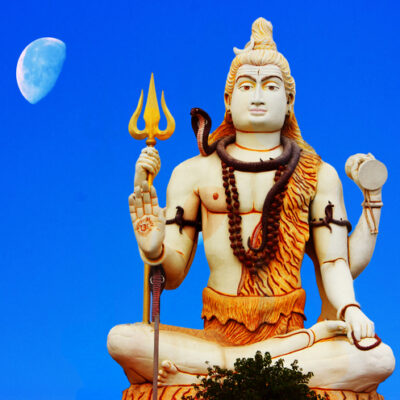Thiruvalanchuzhi Sri Valanchuzhinathar (Kapartheeswarar) Temple, Thanjavur
Address
Thiruvalanchuzhi Sri Valanchuzhinathar (KapartheeswararTemple), Thiruvalanchuzhi Post, Swamimalai Via, Kumbakonam Taluk, Tanjure District, Tamil Nadu – 612 302. Tele: +91 435 – 245 4421 and 245 4026.
Diety
Kapartheeswarar, Valanchuzhinathar Amman: Periyanakai
Introduction
Kabardeeswarar temple (also called Swetha Vinayagar Temple, Vellai Vinayagar temple, Valanchuzinathar temple) is a Hindu temple situated in the village of Thiruvalanchuzhi (also spelt as Thiruvalanjuli) near Swamimalai in Kumbakonam taluk of Thanjavur district, Tamil Nadu, India. Shiva is worshiped as Kabardeeswarar and is represented by the lingam and his consort Parvati is depicted as Brihannayagi. The presiding deity is revered in the 7th century Tamil Saiva canonical work, the Tevaram, written by Tamil poet saints known as the nayanars and classified as Paadal Petra Sthalam. There are many inscriptions associated with the temple indicating contributions from Cholas, Thanjavur Nayaks and Thanjavur Maratha kingdom. The oldest parts of the present masonry structure were built during the Chola dynasty, while later expansions, are attributed to later periods, up to the Thanjavur Nayaks during the 16th century. Thala Virutcham : Vilwa Theertham : Cauvery, Arasalaru, Jada theertham
Puranic Significance
The central temple, according to historian Subramanyan, is an early Chola temple as seen from the inscription (ARE 620 of 1902) made during the reign of Rajaraja I (985–1014 CE) indicating grants made during the 38th regnal year of Madiraikonda Parakesarivarman. One another inscription on the south wall of the mandapa in front of the sanctum dated to Rajaraja indicates grant of land on the 21st year of the rule of Parakesarivarman. An inscription (ARE 633 of 1902) during the 25th regnal year of Rajaraja indicates gift of gold to the deity by Kundavai, the daughter of the king. The temple is associated with a sage called Herandar, who, according to legend, is believed to have gone through an underground passage to the nether world and brought the Kaveri River to the earth to flow into the Bay of Bengal. Since the river took a convoluted direction in its flow, the place is called Tiruvalanjuzhi. There is an image of Herandar in the temple and the trunk of the elephant-headed god, Ganesha (Vinayagar) swirls towards the right.The presence of Buddhist images from the Chola period in the temple show influence of Buddhist tradition in the region. The temple is renowned for its shrine dedicated to Ganesha (Vinayagar, Vinayaka). The idol of Vinayaka is white in colour and is believed to have been created out of sea foam (kadal norai). Hence, the temple is also known as Swetha Vinayagar Temple in Sanskrit or Vellai Vinayakar Temple in Tamil, meaning “the temple of the white Vinayaka”. According to popular legend, Indra, the king of the Devas created the idol of Ganesha out of sea foam during the churning of the ocean and left it in a niche in the temple hoping to get back the idol sometime later. But later, when he returned to remove the idol of Ganesha, it would not budge. So, the idol was allowed to remain where it was. A lattice-worked stone window pane called palahani is present in the temple. The temple is originally believed to have been built by Kanaka Chola in prehistoric times. As per another legend, when Devas (celestial deities) and Asuras (demons) were churning the Ocean of milk with Vasuki the serpent, they disregarded the advice of Vinayaka. It resulted in the spilling of poison in Amruta. To propitiate, the Devas created an image of Vinayaga with sea foam and worshipped him at the place. The image of the presiding deity is white in colour on account of the belief.The temple priests do not conduct abhishekham and pour any liquids over the deity for this reason.
Beliefs
People pray for removal of obstacles in marriage proposals and to have a fair complexion. Devotees perform abishek to Lord and Mother, offer vastras and contribute to temple funds.
Special Features
Lord Shiva in this temple is a Swayambumurthi (self-manifested). This temple is popularly known as “Vellai Pillayar” (White Vinayakar) temple. This east facing temple has three corridors and its main tower (Rajagopuram) has 5-tiers. The last consecration ceremony (Kumbabishekam) took place on 25.03.1981 and prior to that on 27.08.1971. This is one of the “Pancha krosha sthalams”. The others being Thirunallur, Patteswaram, Keezha Pazhayarai and Avoor. It is considered very auspicious to worship all these 5 temples in a single day during “Dakshinayanam”. There are certain stone inscriptions in this temple which date back to the periods of Chola kings Thiribhuvana Chakravarthy, Rajathirajan, Rajakesari Varman, Parakesari Varman, Vikraman and Rajendra Cholan. The west facing temple has a seven-tiered gopura, the gateway tower and has three precincts. The outermost precinct houses the temple tank on the southwest and there is a Bhairava shrine in the northe east in the outermost precinct. The Bhairava shrine is believed to have been built by Loga Mahadevi, the queen of Rajaraja III. The presence of Buddhist images from the Chola period in the temple show influence of Buddhist tradition in the region. The outermost precinct also houses a shrine dedicated to Kshetrapala Devar in the southeast. The second precinct has the shrine of Swetha Vinayagar with artistic pillared halls. The shrine is located in the middle and axial to the gateway tower and the sanctum. The central shrine houses the image of Kabardeeswarar in the form of Linga. The sanctum is square in shape and measures 4.64 m (15.2 ft). The Kshetrapalar is a finely chiseled image measuring 1.65 m (5.4 ft) in height and .85 m (2.8 ft) across the chest. The ardhamandapa, the hall preceding the sanctum projects 4.24 m (13.9 ft) forward and has the same width as the sanctum. The mukhamandapa, the following halls of ardhamandapa measures 6.95 m (22.8 ft) by 6.85 m (22.5 ft). On the outer part of the structures are niches housing Vishnu in the west and Bhairava in the east. The vimana, the structure over the sanctum is semicircular. The halls around the first precinct houses various images and series of Lingams. The southeast corner houses the Valanchuzhi Vinayagar shrine, after which the temple has got one of its names.
Festivals
Vinayakar Chaturthi in the Tamil month of Aavani (Aug-Sept), Navarathri in the Tamil month of Purattasi (Sept-Oct), Skanda Shashti and Annabishekam in the Tamil month of Aippasi (Oct–Nov), Thiru Karthikai in the Tamil month of Karthikai (Nov-Dec), Thiruvadhirai in the Tamil month of Markazhi (Dec-Jan), Makara Sankranthi in the Tamil month of Thai (Jan-Feb), andShivrathri in the Tamil month of Masi (Feb-Mar).Pradosham is also observed regularly.
Century/Period/Age
1000 to 2000 years old
Managed By
Hindu Religious and Charitable Endowments (HRCE)
Nearest Bus Station
Thiruvalanchuzhi
Nearest Railway Station
Kumbakonam
Nearest Airport
Trichy










